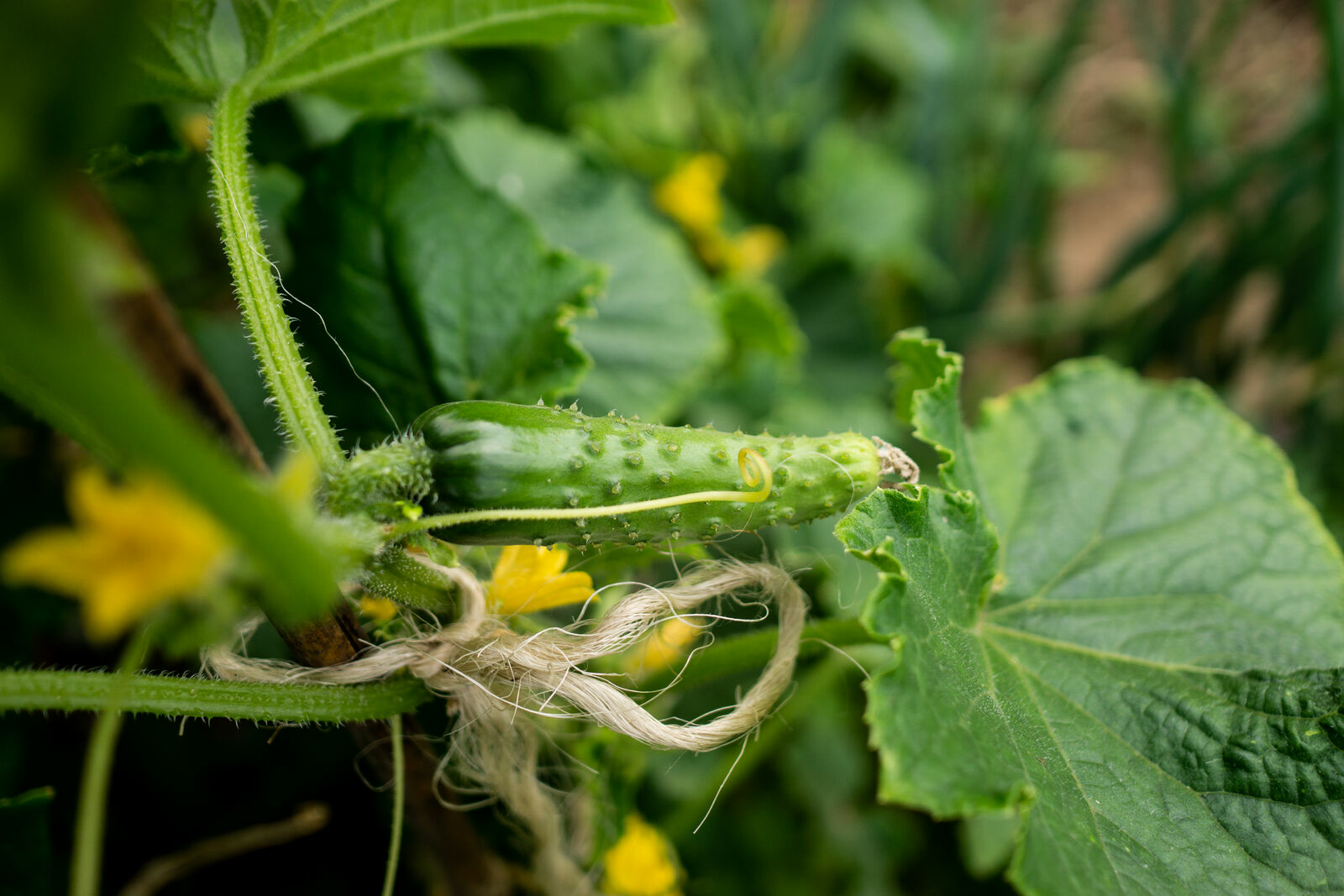
Companion Plants for Cucumbers: What to Plant With Cucumbers
Companion planting offers you as a gardener a number of advantages. The vegetable plants in companion planting are generally more resistant to diseases and pests. In addition to more robust plants in the bed, you also have greater biodiversity in your garden and provide food and habitat for numerous creatures. You can find out which plants are companion plants and which ones are antagonistic plants for cucumber plants in this article. You will also get tips on which plants can prevent mildew on cucumbers.
This Article Contains:
- Planting cucumbers: location, soil & spacing
- Companion planting with cucumber: suitable neighbors
- Cucumber: good and bad companion plants
- Antagonistic plants: this doesn't fit next to cucumbers
- Preventing cucumber diseases: keep mildew at bay with companion planting
- Table: Which plants are compatible with cucumbers?
- Companion planting plan with cucumbers: Examples and ideas
- Succession cropping with cucumbers
- Crop Rotation for healthy soil
- Frequently asked questions about cucumbers in companion planting
Quick Overview
What to plant next to cucumbers?
- Crops with deeper roots such as cabbage, beet, celery, fennel and radicchio go very well next to the shallow-rooted cucumber.
- You can plant ground-covering crops such as lettuce, spinach, nasturtium, lentils, onions and garlic underneath climbing cucumber varieties.
- Nitrogen-fixing plants such as lentils, alfalfa, beans and peas can also be planted next to cucumbers.
- Herbs and flowers such as basil, chervil, parsley, tarragon, dill, marjoram, oregano, fennel, caraway and coriander, marigolds and sunflowers are also good companions for cucumbers.
- Peppers and chili go well next to cucumbers, especially in a greenhouse you can plant these crops together.
- To prevent mildew, garlic, onions, chives, marigolds and various herbs such as basil can help.
Antagonistic plants for cucumbers
- Plants in the same family as zucchinis, melons and pumpkins should not be planted directly next to cucumbers.
- The same applies to Jerusalem artichokes, lovage, sage, radishes, daikon and tomatoes.
Planting cucumbers: location, soil & spacing
Cucumbers are thermophilic plants that need a sunny and wind-protected location. Especially because of their shallow root system and sensitive roots, cucumber plants are very susceptible to wind breakage. In terms of light requirements, cucumber plants are sun worshippers. They need at least 6-8 hours of direct sunlight per day to grow healthy and strong.
The soil should be loose and rich in humus, as cucumbers are heavy feeders. The nutrient requirements of cucumber plants are quite high. In particular, they need sufficient nitrogen, phosphorus and potassium. Regular fertilization, e.g. with compost, can help to cover the nutrient requirements. Sufficient watering is also important, as cucumbers have a high water requirement. When planting, a distance of around 60-80 cm should be maintained between the individual plants to allow sufficient space for growth and ventilation. However, cucumber plants can also be grown vertically, climbing, if you attach an appropriate climbing aid. The cucumber plant then needs significantly less space in the bed. You can find more tips on planting, caring for and harvesting cucumbers in this article.
Companion planting with cucumber: suitable neighbors
Companion planting has the advantage that the plant companions can support each other. With the right companions, many plants grow better and are more resistant to diseases and pests. When choosing the right companions for cucumber plants, you should consider the growth habit, root depth and needs of the plants. Below we give you an overview of companion plants and antagonistic plants with cucumber.

Want to know what to plant next to cucumber?
With our bed planner, you can easily plan a colourful mixed crop. Good and bad neighbours are displayed directly and you get tips on succession planting and crop rotation!
Plan your bed now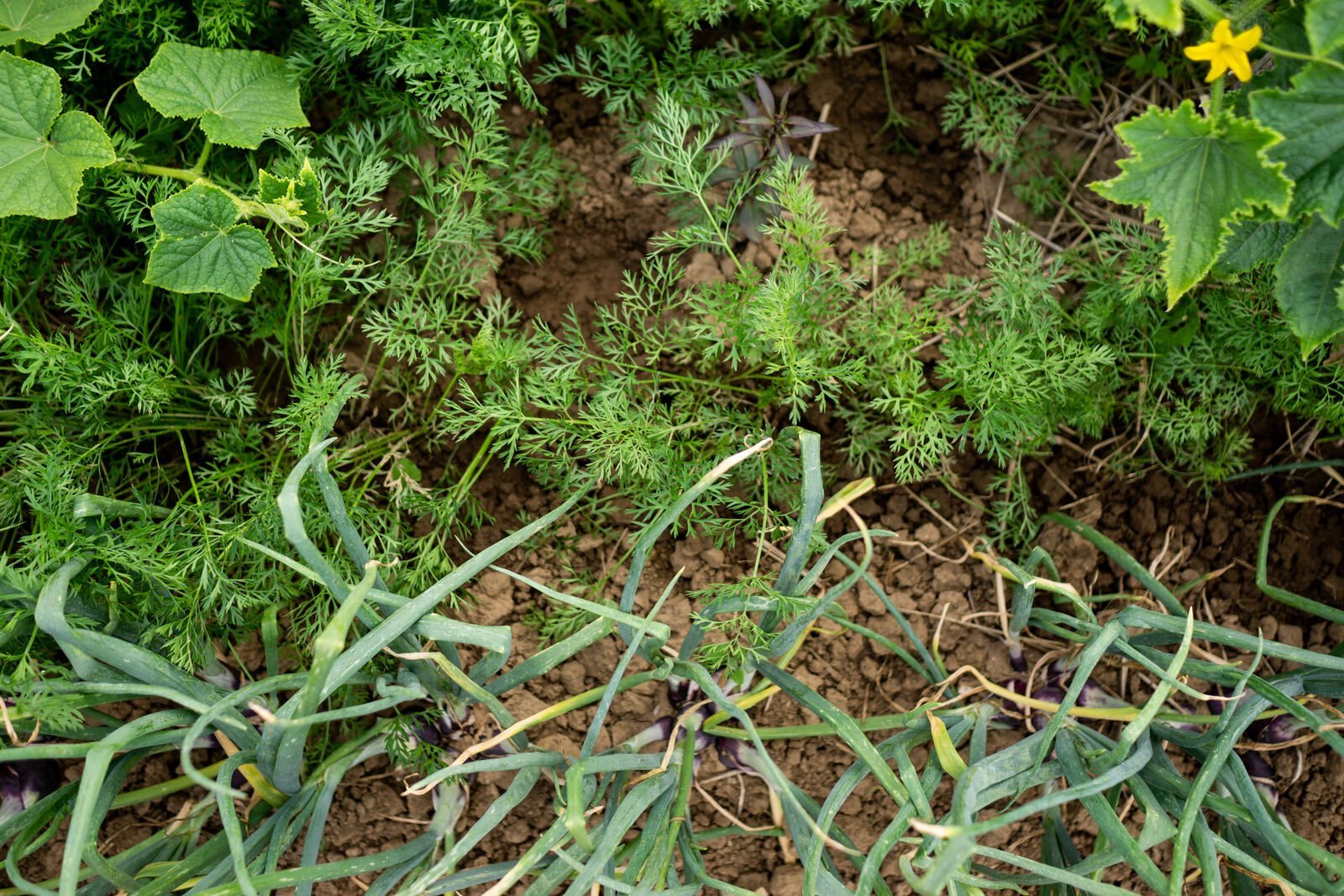
Cucumber: good and bad companion plants
- In terms of roots, plants with different root depths harmonize well with each other. Cucumbers have a shallow root system, so plants with deep roots are good companions. This allows you to make optimum use of the space in the soil and the plants do not compete for nutrients. A wide variety of cabbage species such as cauliflower, broccoli, kohlrabi, kale, white cabbage, savoy cabbage, Brussels sprouts and pak choi are therefore very suitable as compaions for cucumbers. Cabbage plants usually develop medium-deep or deep roots. Although both plants are heavy feeders, they do not take nutrients away from each other. Other plants that go well next to cucumbers due to their root system are, for example , beet, celery stalks and tubers, fennel and radicchio.
- You can grow cucumbers as ground cover and let them creep over the ground. Alternatively, there are also climbing cucumber varieties that grow along a trellis. Most cucumbers, for example, prefer to grow upwards rather than creeping. You can plant ground-covering, low or bushy plants underneath climbing cucumber varieties. For example, you can plant lettuce, spinach, nasturtium, lentils, onions or garlic . These crops shade the soil and thus reduce evaporation of soil water.
- When planning mixed crops, it is also important that the plants complement each other in terms of their nutrient requirements. While cucumbers primarily require nitrogen, legumes such as peas, lentils, alfalfa and beans, for example, are nitrogen fixers and can therefore be a good complement. A combination of plants that require different nutrients can ensure that the soil is not depleted to one side.
Which herbs to plant with cucumbers?
Herbs usually have many advantages in companion planting. With their strong scent, some herbs can keep certain diseases and pests away from the bed. Others improve the growth and aroma of vegetable plants. In addition, the flowers of herbs attract numerous pollinating insects and beneficial insects, which contribute to healthy plants and a rich harvest.
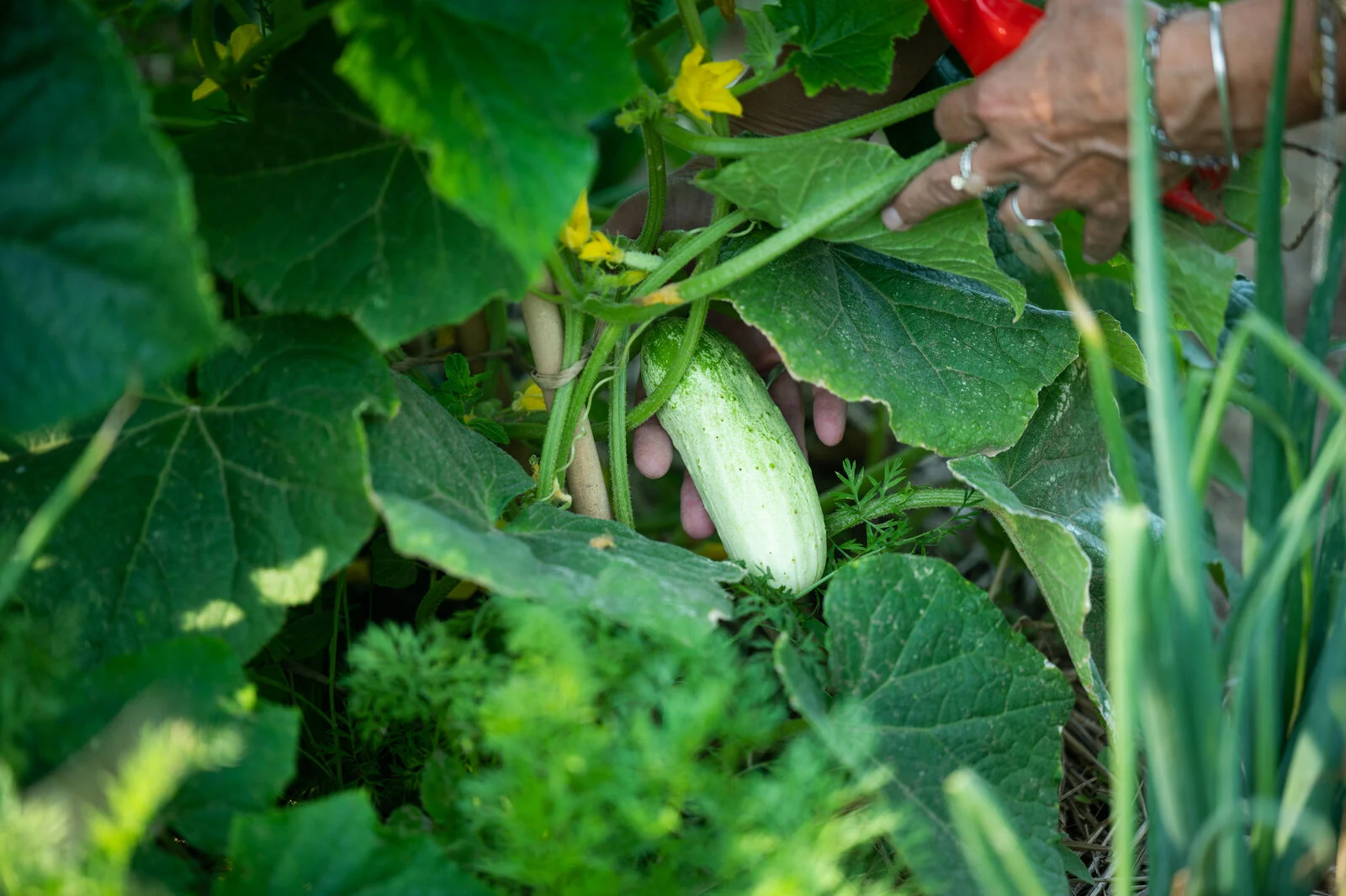
- Some herbs are known to prevent fungal diseases such as mildew: basil, parsley and chervil.
- Chervil is also said to deter slugs and ants. Another effective herb against slugs and snails is tarragon.
- Nasturtium is very popular with aphids. If you want to keep them away from your cucumber plants, simply plant nasturtium near them.
- Dill promotes the germination of its companion plants. When direct sowing in the open field or greenhouse, you can sow dill next to cucumbers.
- Herbs such as marjoram, oregano, fennel, caraway and coriander are said to improve the growth and flavor of a vegetable crop.
- As most herbs flower every year, they attract beneficial insects. But most flowers have even more positive properties. Sunflowers, for example, can also serve as a climbing aid for cucumbers. Marigolds and marigolds can keep wireworms and nematodes away from the soil.
Companion plants for cucumbers in the greenhouse
Conditions in the greenhouse are different from those in the open field. Therefore, when selecting plant companions for cucumbers in the greenhouse, you should choose plants with similar requirements in terms of temperature, humidity and light conditions. Here are some companion plants for cucumbers in the greenhouse:
- Peppers and chilies: As they have similar light, water and nutrient requirements to cucumbers, peppers and chilies make good companions in the greenhouse. They thrive at similar temperatures and also require high humidity. In addition, peppers and chilies form deeper roots than cucumber plants, which is why they complement each other well.
- Herbs such as basil, dill, parsley and marigolds: As cucumbers are usually cultivated as climbing cucumbers in greenhouses, you can sow or plant ground-covering crops underneath them. Herbs have many other advantages, as mentioned above.
In a greenhouse, it is important to ensure sufficient ventilation and good plant hygiene to prevent diseases and pests. Fungal diseases in particular can spread very quickly without good ventilation and lead to large crop failures. You can also prune the cucumber plants and remove leaves if necessary to improve aeration in the crop.
Your companion planting plan with cucumbers, peppers and herbs: Example for the greenhouse
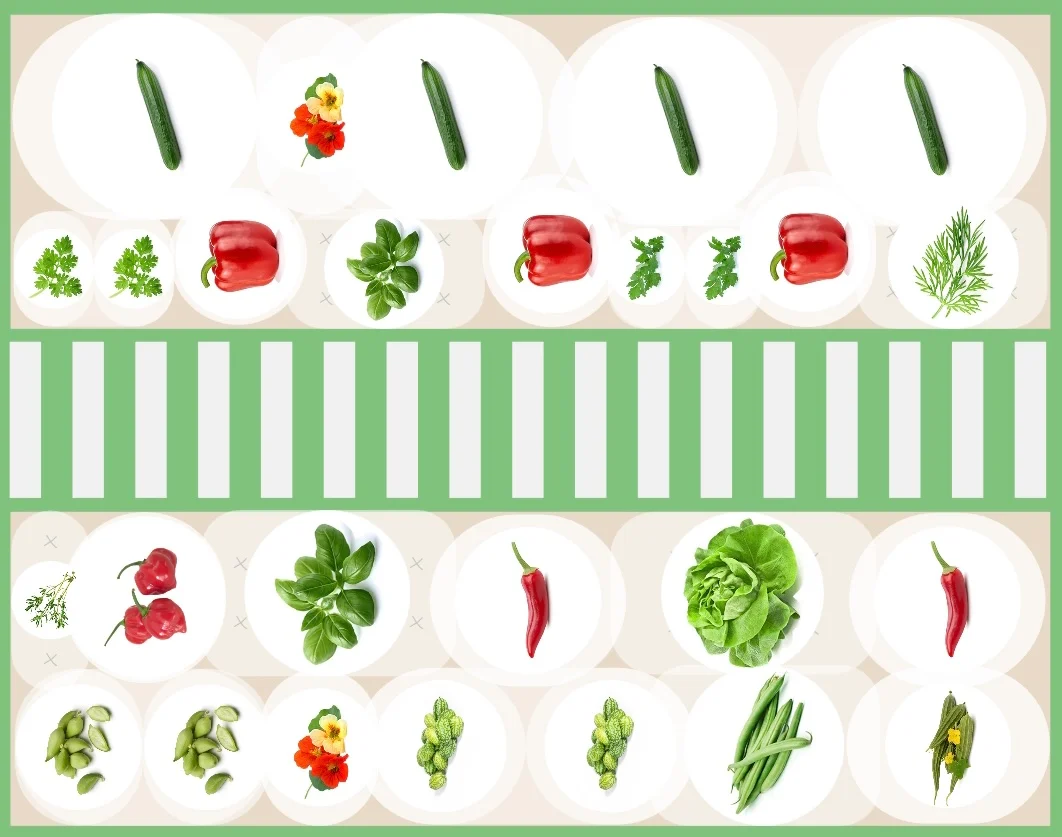
In this planting plan you will find ideas for your greenhouse with cucumbers, peppers and chilies. In the greenhouse, cucumbers are usually grown vertically and need a climbing support. You can plant other climbing plants, such as nasturtiums, between the cucumbers. Alternatively, you can also plant bush beans in between, which are nitrogen fixers and accumulate nutrients in the soil, especially nitrogen. This benefits the hungry cucumber plants. Bell pepper and chili plants are staggered in front of the cucumbers. Numerous herbs such as basil, parsley, chervil, savory and dill grow as ground cover plants among the heavy feeders. You can try out a wide variety of cucumber varieties: In addition to high-yielding snake cucumbers such as 'Marketmore' and 'La Diva', exotic varieties such as 'Mexican mini cucumbers' and the 'squirrel gourd' also grow in this greenhouse. You can also plant a sponge cucumber, the fruits of which can be used as an ecological sponge in the kitchen or bathroom. You can find a list of seed-resistant, organic cucumber varieties with other special varieties, such as yellow cucumbers, in this article.
Antagonistic plants: this doesn't fit next to cucumbers
Some crops should be planted in a different bed to the cucumber plants or at least at a good distance from them. As a general rule, plants from the same plant family, such as pumpkins and zucchinis, should not be planted next to cucumbers. These plants have similar nutrient, light and water requirements, which would result in competition for these resources. Especially because other pumpkin plants also only develop shallow roots. Cucumbers and Jerusalem artichokes are an equally bad combination. Jerusalem artichokes spread their roots widely and can therefore be in direct competition with shallow-rooted cucumbers. This can lead to growth and nutrient problems for both plants. Lovage and sage are also antagonistic, as they inhibit the growth of cucumber plants. An equally problematic companion planting is with radishes and daikon. These two crops are susceptible to the same diseases and pests, which greatly increases the risk of infestation. The same applies to tomatoes.
Planting cucumbers and tomatoes together?
Planting cucumbers and tomatoes right next to each other is often not recommended. These two plants often have similar requirements for nutrients, water and light, which can lead to competition. Both plants are heavy feeders and require a lot of nitrogen for healthy growth. However, unlike cucumbers, tomatoes have a deep root system. With sufficient fertilization, you may be able to plant these two heavy feeders together.
A much bigger problem is that both crops are susceptible to mildew. In addition, both need different optimum humidity levels. Cucumbers thrive in high humidity, while tomatoes prefer lower humidity. If the humidity is too high, this can lead to fungal diseases in tomato plants. So if you are struggling with mildew in your garden or greenhouse, it is better not to plant these two crops right next to each other. If you do decide to do this, it is advisable to ensure that there is sufficient distance and that the plants are well ventilated. For example, you can cut cucumbers and defoliate tomatoes. Some herbs also help to prevent mildew.
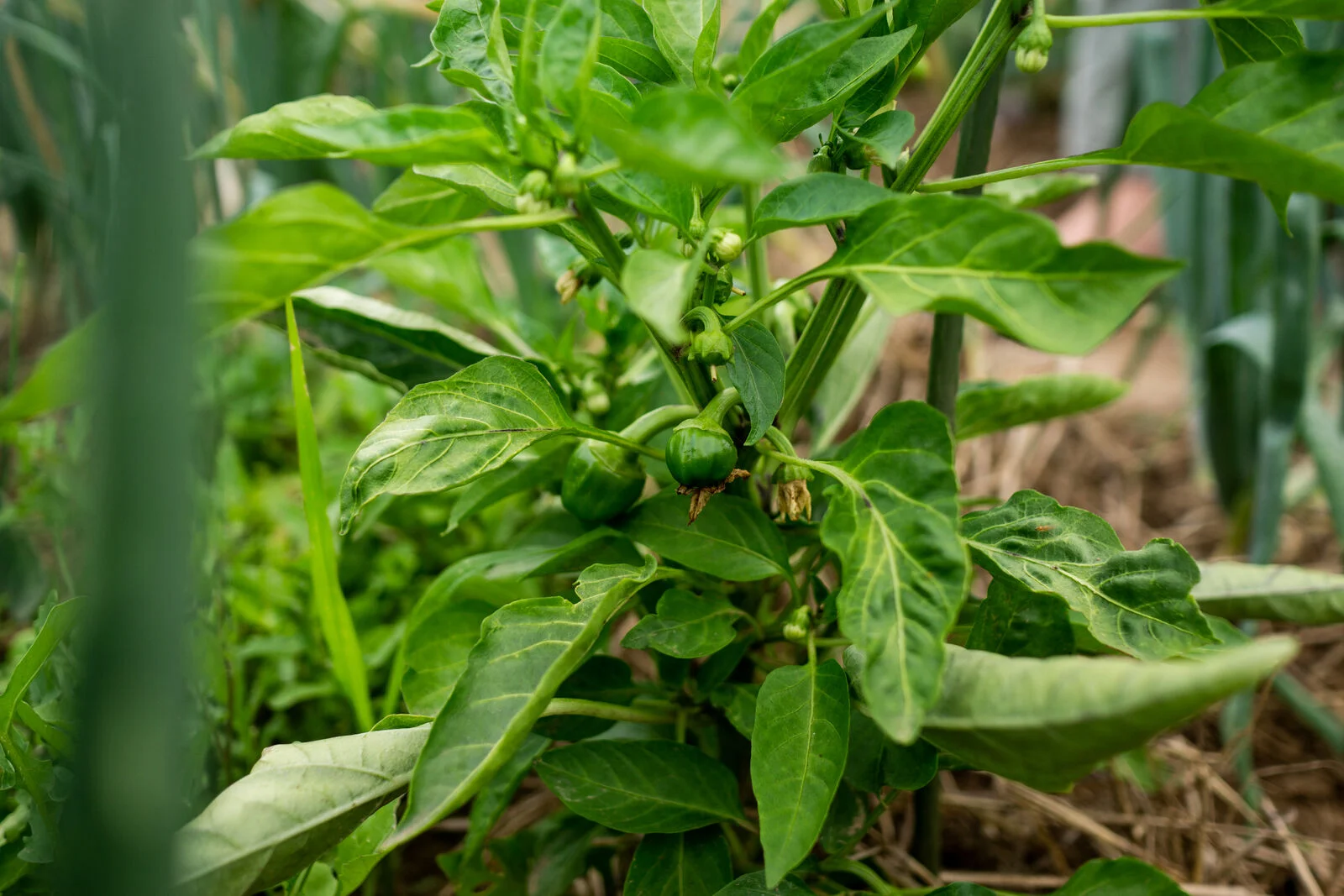
Planting cucumbers and zucchinis together?
As with companion planting with tomatoes, zucchini plants have similar requirements to cucumbers. Planting cucumbers and zucchini right next to each other can lead to competition for nutrients, water and light, which can affect the growth and productivity of both plants.
Another reason why cucumbers and zucchini are considered antagonistic plants is that they are both susceptible to similar diseases and pests, such as powdery mildew, aphids or squash flies. Planting these two vegetables together can increase the risk of diseases and pests spreading from one plant to the other.
Preventing cucumber diseases: keep mildew at bay with companion planting
Powdery mildew is a common fungal disease that can affect cucumber plants. To prevent mildew and reduce the risk of infestation, growing mixed crops can be helpful. Here are some plants that can reduce mildew infestation in combination with cucumbers:
- Garlic: Garlic acts as a natural fungicide and can help prevent mildew on cucumber plants. The same applies to onions and chives.
- Marigolds: Marigolds can attract beneficial insects such as ladybugs that eat aphids and other pests. Since aphids can transmit viruses that weaken the plant and increase the risk of powdery mildew, marigolds are a good mixed crop to prevent powdery mildew.
- Herbs: Various herbs such as basil, chervil and parsley can be planted alongside cucumbers and act as natural defenses against pests and diseases, including powdery mildew.
Table: Which plants are compatible with cucumbers?
| Companion plants (Vegetables) | Companion plants (Herbs) | Antagonistic plants |
|---|---|---|
| Beans | Basil | Pumpkin |
| Chilli | Dill | Lovage |
| Pea | Tarragon | Radishes |
| Fennel | Chervil | Radish |
| Nasturtium | Coriander | Sage |
| Garlic | Cumin | Tomatoes |
| Beetroot | Marjoram | Jerusalem artichoke |
| Lentils | Oregano | Zucchini |
| Maize | Parsley | |
| Paprika | Marigold | |
| Radicchio | ||
| Celery | ||
| Asparagus | ||
| Cabbage (cauliflower, broccoli, kale, kohlrabi, pak choi, Brussels sprouts, white cabbage, savoy cabbage) |
Companion planting plan with cucumbers: Examples and ideas
As you've already seen, it's definitely worth planting cucumbers in companion plantings. As inspiration for your own cucumber bed, we have prepared some bed plans with cucumbers. In addition to cucumber beds in the garden, you will also find ideas for small vertical beds on the balcony.
Succession cropping with cucumbers
Succession cropping is an important concept in horticulture to maintain soil health and yields. For sensible succession cropping, you must bear in mind that cucumbers are heavy feeders. It's best to grow weak or medium-performing crops before and after them. Alternatively, you can also sow green manure or legumes to increase soil fertility and add nutrients to the system. Legumes are so-called nitrogen fixers. If you plant legumes after cucumbers, you can increase the nutrient content in a natural way.
Crop Rotation for healthy soil
With good crop rotation, you also contribute to good soil fertility and prevent pests and diseases. The general rule here is to refrain from growing a crop of the same family for around three to four years. This means that for three years, no melon, zucchini or pumpkin plants are grown where a pumpkin plant previously stood. To do this, you should draw up a multi-year plan in which the cultivation sequence is determined for several years in advance.
In the right location, cucumbers can grow super high yields. I hope you now have everything you need to successfully grow your own cucumber plants.
If you have any questions or comments, please write to us at [email protected]. Would you like to receive helpful gardening tips all year round and plan your own beds optimally? Then register here or download the Fryd app for Android or iOS.
Fryd - your digital bed planner

Marie
Marie is an agronomist. She is particularly interested in the sustainable and organic cultivation of vegetables and other plants. In her own garden, she gained experience and likes to try things out to learn from nature. She is particularly interested in the values and principles of permaculture, in order to contribute not only to the well-being of nature, but also to the well-being of people and future generations.
Learn MoreCurrent Topics in the Community


Liked 4 times
Hello folks, Today, after almost a year, I took my turmeric plant out of the flower pot that was on our windowsill. I think it's not bad for a 14x14 pot without any special care. On the left is the mother rhizome, which is also edible.
Show 2 answers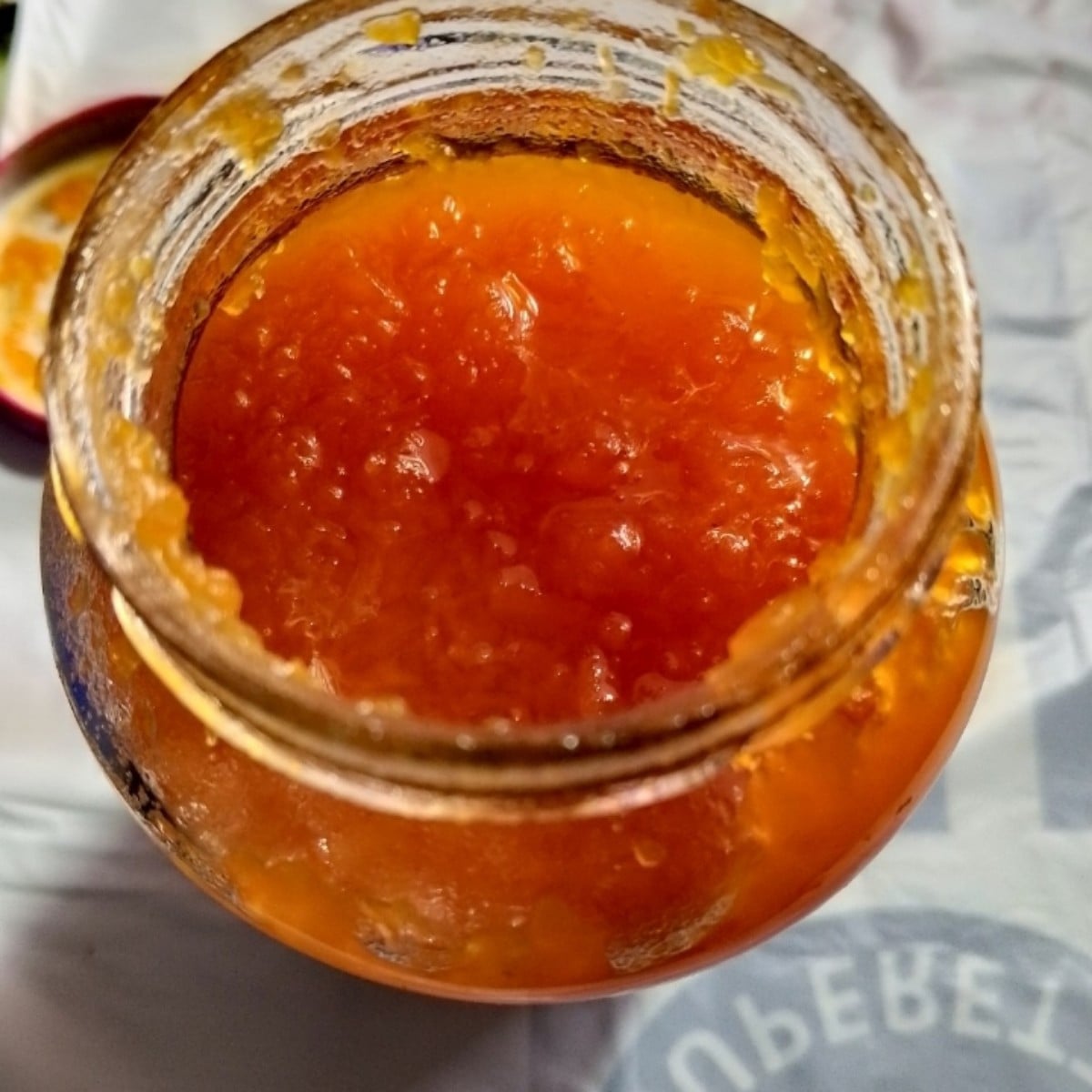
Liked 13 times
Pumpkin jam Cinnamon sticks are added for flavor. It tastes great, do you make pumpkin jam in Europe?
Show 5 answers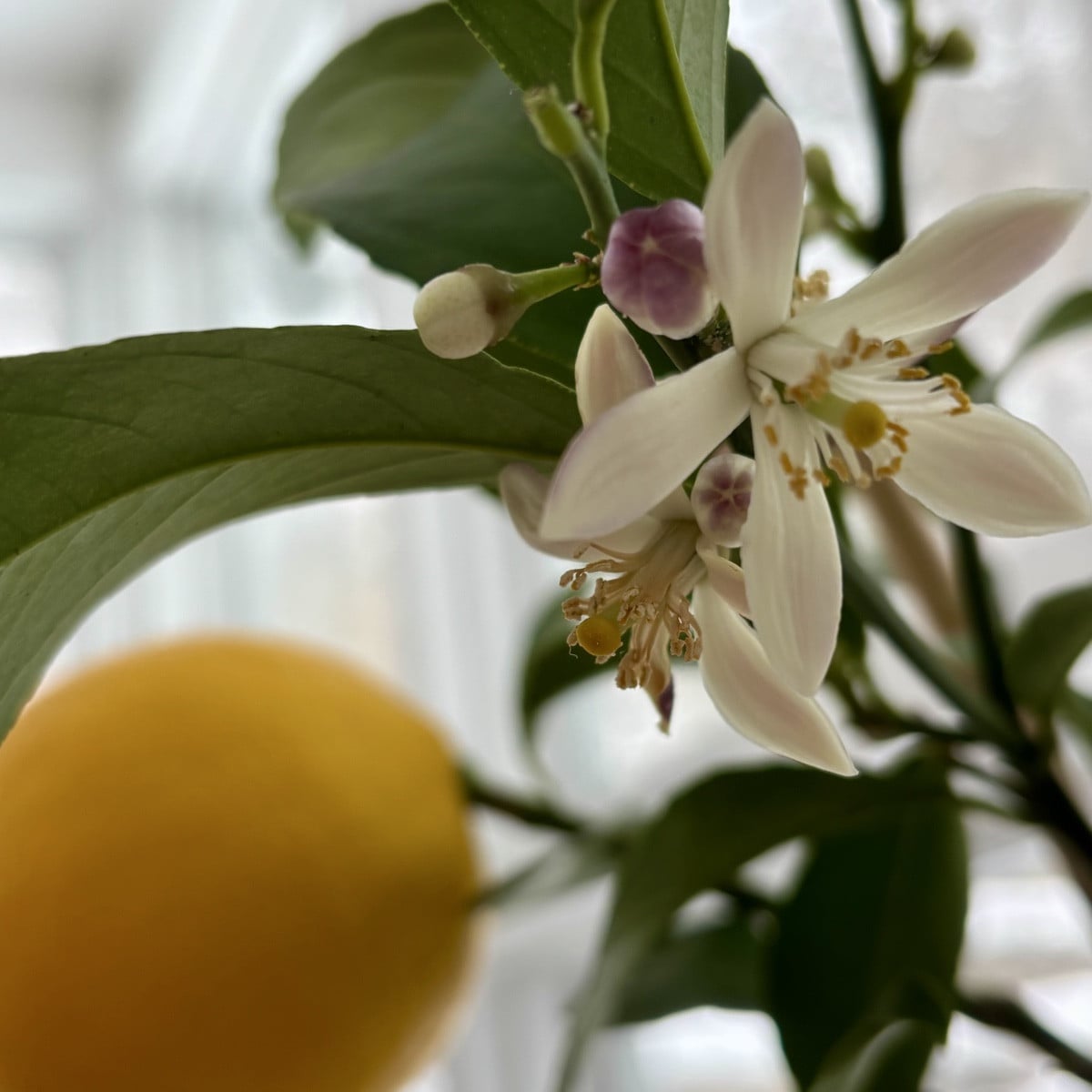
Liked 19 times
There's snow outside, but inside it smells of citrus blossom 🥰🍋🌸
Show 1 answerPopular Articles

Overwintering Parsley: How to Do It Successfully

How to Grow Lettuce in Winter: Varieties, Sowing, Harvesting

Growing Sage Plant: Tips for Sowing and Harvesting

What Herbs Can Be Planted Together?

Create & Design a Permaculture Garden

Overwintering Plants: Tubs, Pots and Raised Beds

Pruning, Fertilizing & Propagating Currants: Care Tips

Pruning Raspberries: How to Do It

Vegetable Garden With Greenhouse: How to Use Greenhouse Effect

Winterizing Beds and the Garden: How to Do It
FAQ
What can you plant with cucumbers?
Cucumbers have some good neighbors and you can, for example, plant cabbage, lettuce, spinach, onions, celery and fennel next to cucumbers. Some herbs such as basil, parsley and chervil also go well with cucumbers.
What should you not plant next to cucumbers?
Plants from the same family (zucchinis, melons and pumpkins) go less well with cucumbers. You should also avoid planting sage, radishes, radishes and tomatoes directly next to cucumbers.
Can you plant cucumbers and tomatoes together?
Cucumbers and tomatoes are both crops that are very susceptible to mildew. If you have problems with this fungus, you should not plant these two crops right next to each other. In addition, cucumbers prefer higher humidity, which in turn favors a fungal infection in tomatoes.
Do cucumbers and peppers go well together?
Peppers and cucumbers are a good mixed crop. Although both plants are heavy feeders, they complement each other very well in their growth habit both above and below ground. You can grow these two crops well together, especially in a greenhouse.